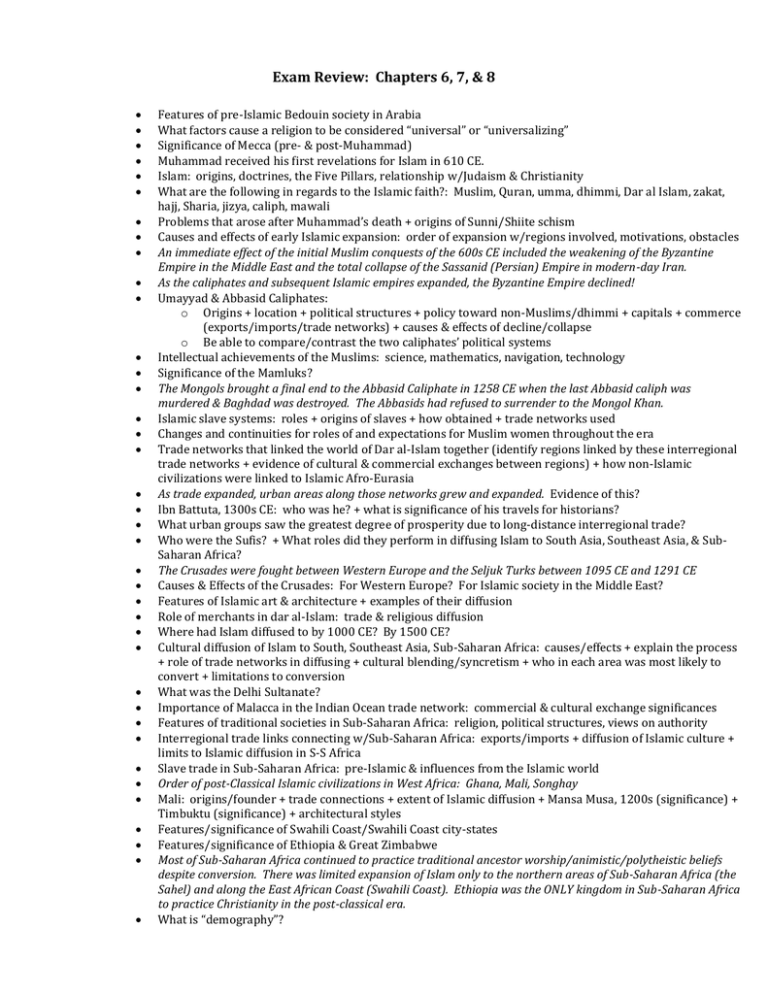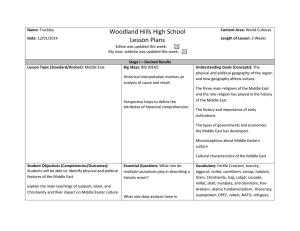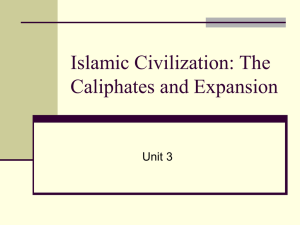Exam Review: Chapters 6, 7, & 8
advertisement

Exam Review: Chapters 6, 7, & 8 Features of pre-Islamic Bedouin society in Arabia What factors cause a religion to be considered “universal” or “universalizing” Significance of Mecca (pre- & post-Muhammad) Muhammad received his first revelations for Islam in 610 CE. Islam: origins, doctrines, the Five Pillars, relationship w/Judaism & Christianity What are the following in regards to the Islamic faith?: Muslim, Quran, umma, dhimmi, Dar al Islam, zakat, hajj, Sharia, jizya, caliph, mawali Problems that arose after Muhammad’s death + origins of Sunni/Shiite schism Causes and effects of early Islamic expansion: order of expansion w/regions involved, motivations, obstacles An immediate effect of the initial Muslim conquests of the 600s CE included the weakening of the Byzantine Empire in the Middle East and the total collapse of the Sassanid (Persian) Empire in modern-day Iran. As the caliphates and subsequent Islamic empires expanded, the Byzantine Empire declined! Umayyad & Abbasid Caliphates: o Origins + location + political structures + policy toward non-Muslims/dhimmi + capitals + commerce (exports/imports/trade networks) + causes & effects of decline/collapse o Be able to compare/contrast the two caliphates’ political systems Intellectual achievements of the Muslims: science, mathematics, navigation, technology Significance of the Mamluks? The Mongols brought a final end to the Abbasid Caliphate in 1258 CE when the last Abbasid caliph was murdered & Baghdad was destroyed. The Abbasids had refused to surrender to the Mongol Khan. Islamic slave systems: roles + origins of slaves + how obtained + trade networks used Changes and continuities for roles of and expectations for Muslim women throughout the era Trade networks that linked the world of Dar al-Islam together (identify regions linked by these interregional trade networks + evidence of cultural & commercial exchanges between regions) + how non-Islamic civilizations were linked to Islamic Afro-Eurasia As trade expanded, urban areas along those networks grew and expanded. Evidence of this? Ibn Battuta, 1300s CE: who was he? + what is significance of his travels for historians? What urban groups saw the greatest degree of prosperity due to long-distance interregional trade? Who were the Sufis? + What roles did they perform in diffusing Islam to South Asia, Southeast Asia, & SubSaharan Africa? The Crusades were fought between Western Europe and the Seljuk Turks between 1095 CE and 1291 CE Causes & Effects of the Crusades: For Western Europe? For Islamic society in the Middle East? Features of Islamic art & architecture + examples of their diffusion Role of merchants in dar al-Islam: trade & religious diffusion Where had Islam diffused to by 1000 CE? By 1500 CE? Cultural diffusion of Islam to South, Southeast Asia, Sub-Saharan Africa: causes/effects + explain the process + role of trade networks in diffusing + cultural blending/syncretism + who in each area was most likely to convert + limitations to conversion What was the Delhi Sultanate? Importance of Malacca in the Indian Ocean trade network: commercial & cultural exchange significances Features of traditional societies in Sub-Saharan Africa: religion, political structures, views on authority Interregional trade links connecting w/Sub-Saharan Africa: exports/imports + diffusion of Islamic culture + limits to Islamic diffusion in S-S Africa Slave trade in Sub-Saharan Africa: pre-Islamic & influences from the Islamic world Order of post-Classical Islamic civilizations in West Africa: Ghana, Mali, Songhay Mali: origins/founder + trade connections + extent of Islamic diffusion + Mansa Musa, 1200s (significance) + Timbuktu (significance) + architectural styles Features/significance of Swahili Coast/Swahili Coast city-states Features/significance of Ethiopia & Great Zimbabwe Most of Sub-Saharan Africa continued to practice traditional ancestor worship/animistic/polytheistic beliefs despite conversion. There was limited expansion of Islam only to the northern areas of Sub-Saharan Africa (the Sahel) and along the East African Coast (Swahili Coast). Ethiopia was the ONLY kingdom in Sub-Saharan Africa to practice Christianity in the post-classical era. What is “demography”?



